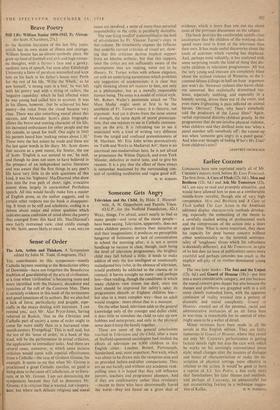Sense of Order
The Arts, Artists and Thinkers, A Symposium edited by John M. Todd. (Longmans, 35s.) THE contributors to this symposium—mostly Catholic laymen meeting at the Benedictine abbey of Downside—have not forgotten the Benedictine tradition of guardianship of the arts of civilisation, at a time when 'civilisation' is becoming more and more identified with the blatancy, decadence and cynicism of the cult of the Common Man. There is certainly evidence in this book of the seriousness and good intentions of its authors. But we also feel a lick of force, particularity and grapple, espe- cially in the essays dealing with literature. '1 can remind you,' says Mr. Alan Pryce-Jones, having referred to Ruskin, 'that to the Christian and Catholic part of society a sense of order ought to come far more easily than to a harrassed nine- teenth-century Evangelical.' This is well said, but the test of the 'sense of order,' in a book of this kind, will be the performance in actual criticism, the application to immediate tasks. And there are several cases, moreover, in which some incisive criticism would come with especial effectiveness from a Catholic—the case of Graham Greene, for example. It seems to me that when Mr. Greene is proclaimed a great Catholic novelist, no good is being done to the cause of Catholicism, or to litera- ture, or to Mr. Greene. I am not denouncing the symposiasts because they fail to denounce Mr. Greene; it is criticism that is wanted, not vitupera- tion; but where such delicate religious and moral
issues are involved, a sense of more-than-personal responsibility in the critic is peculiarly desirable.
The 'one thing needful' is exemplified in the field of art-criticism by Fr. Vincent Turner's essay in this volume. He trenchantly exposes the fallacies that underlie current criticism of visual art, show- ing that this criticism derives implicit support from an Idealist esthetic, but that this support, since the critics are not sufficiently aware of the assumptions they are making, turns out to be illusory. Fr. Turner writes with urbane elegance, yet with an underlying earnestness which prohibits any suggestion of academicism; it is clear that right thinking about art matters to him, not only as a philosopher, but as a morally responsible human being. The essay is a model of critical style. Mr. Robert Waller's passionate attack on 'The Mass Media' might seem at first to be the antithesis of Fr. Turner's essay; it is rhetoric, not argument. And yet it draws from the same source of strength, the same depth of moral preoccupa- tion, that one rejoices to see in Catholic commen- tary on the arts. It is refreshing too to see it associated with a kind of writing very different from the turgid and confused pretentiousness of M. Maritain. Mr. Eric John writes provocatively on 'Faith and Works in Mediaeval Art'; there is no uncritical neo-medievalism here, he is not afraid to pronounce the Wilton Diptych, and even York Minster, defective in moral taste, and to give his reasons. It is a pity that the effect of these essays is somewhat weakened by the surrounding con- text of rambling meditation and vague good will.
W. w. ROBSON


























 Previous page
Previous page